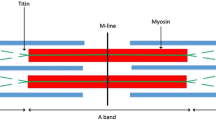Summary
In rock lobsters,Panilurus vulgaris, Jasus lalandii, the coxo-basipodite (C-B) and the mero-carpopodite (M-C) joints are mainly involved in body posture and in locomotion. In order to determine the functional relationships between these two joints the reflex effects induced by the C-B and M-C proprioceptors onto the muscles of their own joint (intrasegmental reflexes) or of the other joint (intersegmental reflexes) have been studied.
In addition to these proprioceptive actions the motor function of the cuticular stress detector sensory organ (CSD) has also been studied.
Three different reflex patterns can be obtained:
-
1.
Diffuse facilitation. Pressure applied on the CSD organ generally increases both tonic and reflex activity of the C-B and M-C muscles (Figs. 2, 4, 5, 7). M-C extension activates simultaneously depressor and levator C-B muscle discharges (Figs. 3, 4).
-
2.
Reciprocal reflex effects. At the level of each joint the well known resistance reflexes modulate in opposite ways the antagonistic muscles. Stretch and release of the CB chordotonal organ respectively activate the levator and depressor C-B muscles (Fig. 2). The M-C joint flexion activates the extensor M-C muscle, the M-C joint extension increases the discharge of the flexor and accessory flexor M-C muscles (Fig. 5).
-
In addition, CB chordotonal organ acts similarly on the M-C muscles. Its stretch increases the extensor activity, its release increasing the flexor and accessory flexor discharges (Figs. 6–7).
-
3.
Selective modulation of motoneuron activities. Some sensory inputs can differentially modulate the activities of the different motoneurones of a given muscle (Figs. 3–6).
Similar content being viewed by others
Abbreviations
- C-B :
-
coxo-basipodit joint
- CB :
-
C-B joint chordotonal organ
- M-C :
-
mero-carpopodite joint
- MC :
-
M-C joint chordotonal organs (two sensory organs, MC1 and MC2)
- MCO :
-
myochordotonal organ
- CSD :
-
cuticular stress detector
- PD :
-
P-D (propo-dactylopodite) joint chordotonal organ
References
Alexandrowicz, J.S.: Receptor organs in the coxal region ofPalinurus vulgaris. J. Mar. Biol. Ass. U.K.47, 415–432 (1967)
Alexandrowicz, J.S.: The comparative anatomy of leg proprioceptors in some decapod Crustacea. J. Mar. Biol. Ass. U.K.52, 605–634 (1972)
Alexandrowicz, J.S., Whitear, M.: Receptor elements in the coxal region of Decapoda Crustacea. J. Mar. Biol. Ass. U.K.36, 603–628 (1957)
Angaut-Petit, D., Clarac, F.: A study of a temporal relationship between two excitatory motor discharges in the crayfish. Brain Res.104, 166–170 (1976)
Ayers, J., Davis, W.J.: Neuronal control of locomotion in the lobsterHomarus americanus. II. Types of walking leg reflexes. J. comp. Physiol.115, 29–46 (1977)
Bässler, U.: Reversal of a reflex to a single motoneuron in the stick InsectCarausius morosus. Biol. Cybernetics24, 47–49 (1976)
Bliss, D.E.: Autotomy and regeneration. In: The physiology of crustacea, Vol. I. Waterman, T.H. (ed.), pp. 561–589 (1960)
Burke, W.: An organ for proprioception and vibration sense inCarcinus maenas. J. Exp. Biol.31, 127–137 (1954)
Bush, B.M.H.: Proprioception by the coxo-basal chordotonal organ CB, in legs of the crabCarcinus maenas. J. Exp. Biol.42, 285–297 (1965a)
Bush, B.M.H.: Leg reflexes from chordotonal organs in the crabCarcinus maenas. Comp. Biochem. Physiol.15, 567–587 (1965b)
Bush, B.M.H., Vedel, J.P., Clarac, F.: Intersegmental reflex action from a joint sensory organ (CB) to a muscle receptor (MCO) in decapod Crustacean limbs. J. Exp. Biol.73, 47–63 (1978)
Clarac, F.: Crustacean cuticular stress detector. In: Structure and function of proprioceptors in the invertebrates. Mill, P.J. (ed.), pp. 299–321. London: Chapman and Hall 1976
Clarac, F., Vedel, J.P.: Etude des relations fonctionnelles entre le muscle fléchisseur accessoire et les organes sensoriels chordotonaux et myochordotonaux des appendices locomoteurs de la langoustePalinurus vulgaris. Z. vergl. Physiol.72, 386–410 (1971)
Clarac, F., Wales, W., Laverack, M.S.: Stress detection at the autotomy plane in decapod crustacea. II. The function of the receptors associated with the cuticle of the basi-ischiopodite. Z. vergl. Physiol.73, 383–407 (1971)
Clarac, F., Vedel, J.P., Bush, B.M.H.: Intersegmental reflex coordination by a single joint receptor organ (CB) in rock lobster walking legs. J. Exp. Biol.73, 29–46 (1978)
Cohen, M.J.: The dual role of sensory systems: detection and setting central excitability. Cold Spring Harbor Symp. Quant. Biol.30, 587–599 (1965)
Evoy, W.H., Cohen, M.J.: Sensory and motor interaction in the locomotor reflexes of crabs. J. Exp. Biol.51, 151–169 (1969)
McVean, A.: The nervous control of autotomy inCarcinus maenas. J. Exp. Biol.60, 423–436 (1974)
McVean, A., Findlay, I.: Autotomy inCarcinus maenas: the role of the basi-ischiopodite posterior levator muscle. J. comp. Physiol.110, 367–381 (1976)
Moffett, S.B.: Motor patterns and structural interactions of basi-ischiopodite levator muscles in routine limb elevation and production of autotomy in the land crabsCardisoma guanhumi. J. comp. Physiol.96, 285–305 (1975)
Vedel, J.P., Angaut-Petit, D., Clarac, F.: Reflex modulations of motoneurone activity in the leg of the crayfishAstacus leptodactylus. J. Exp. Biol.63, 551–567 (1975)
Wiens, T.J., Gerstein, G.L.: Reflex pathways of the crayfish claw. J. comp. Physiol.107, 309–326 (1976)
Author information
Authors and Affiliations
Additional information
This work was supported by an INSERM Grant (A.T.P. N∘ 21.76.61.011).
Rights and permissions
About this article
Cite this article
Vedel, J.P., Clarac, F. Combined reflex actions by several proprioceptive inputs in the rock lobster walking legs. J. Comp. Physiol. 130, 251–258 (1979). https://doi.org/10.1007/BF00614611
Accepted:
Issue Date:
DOI: https://doi.org/10.1007/BF00614611




